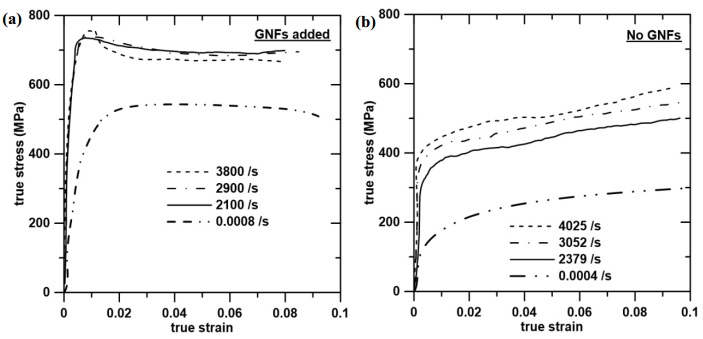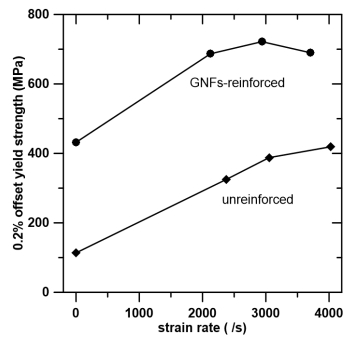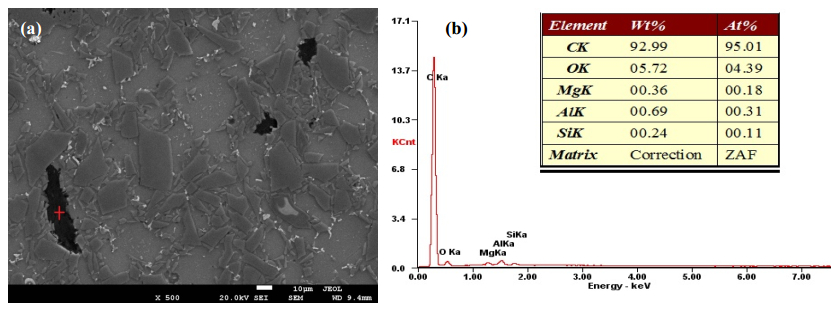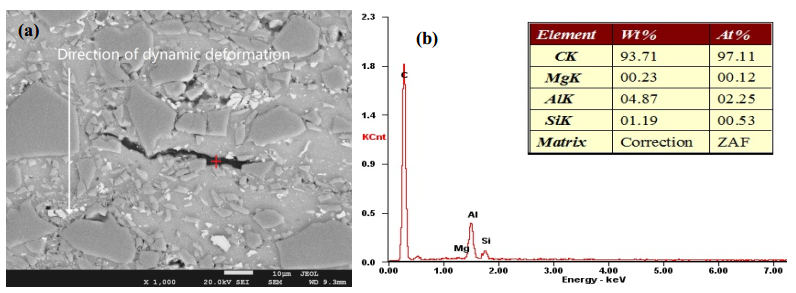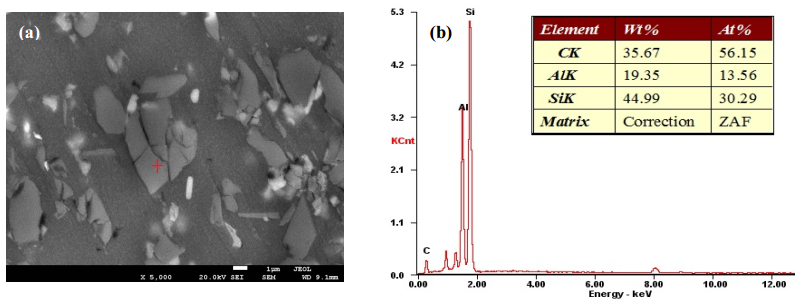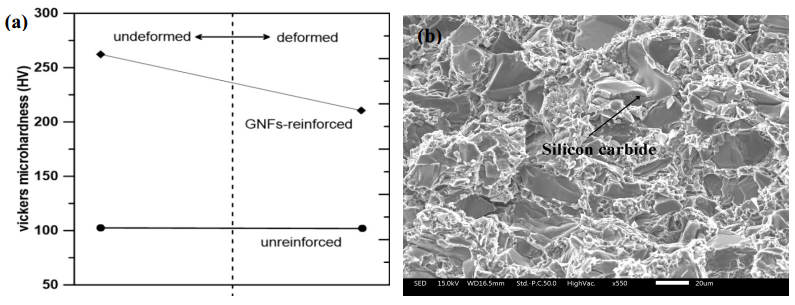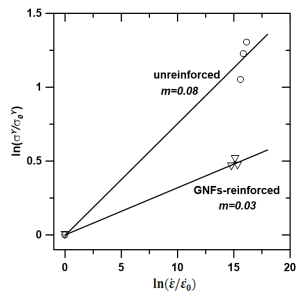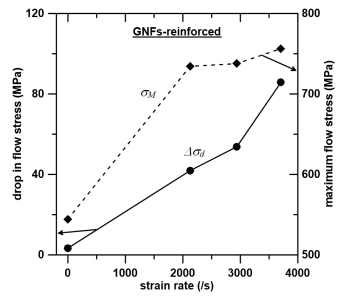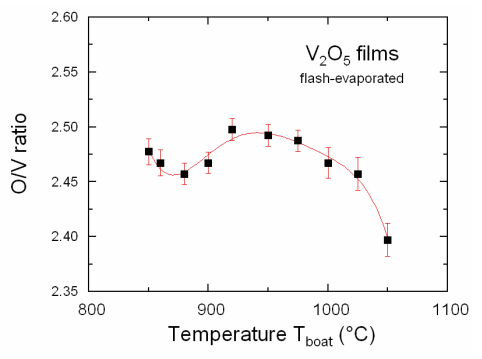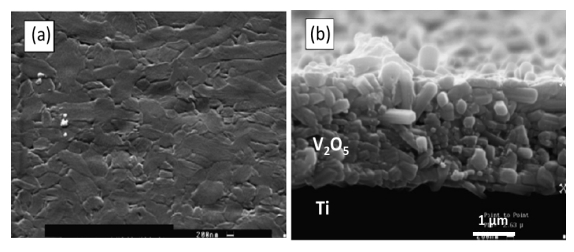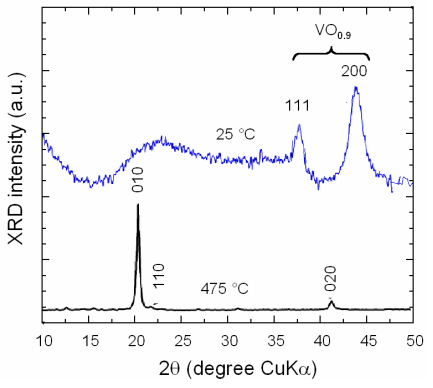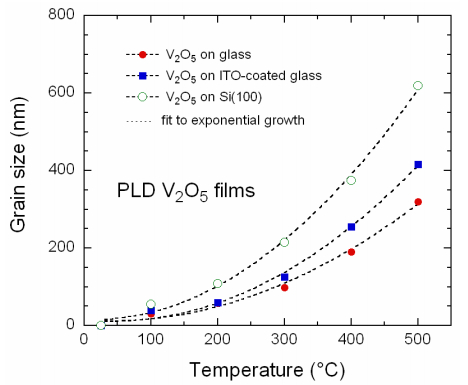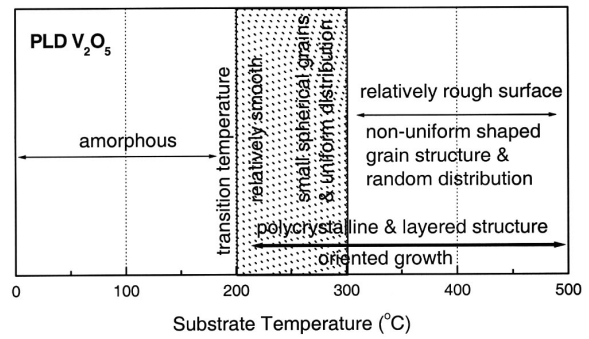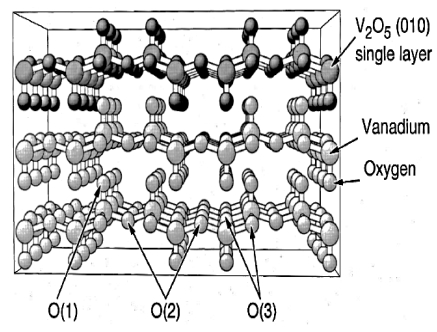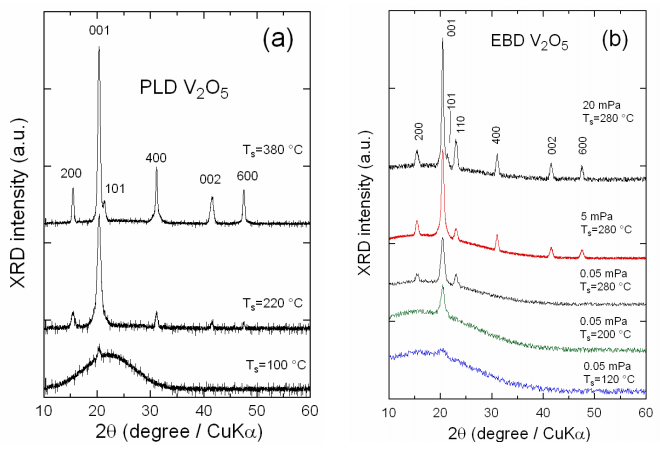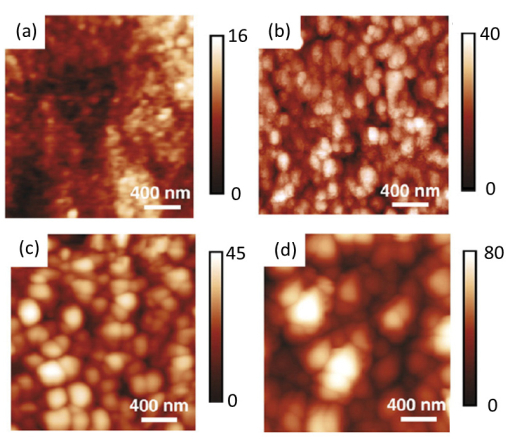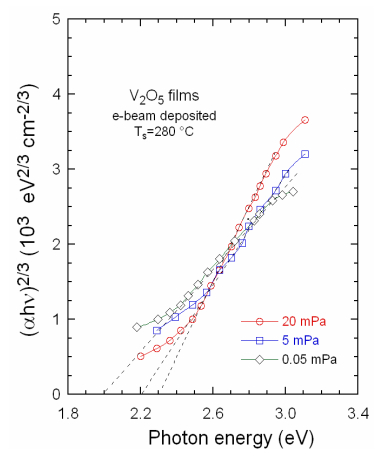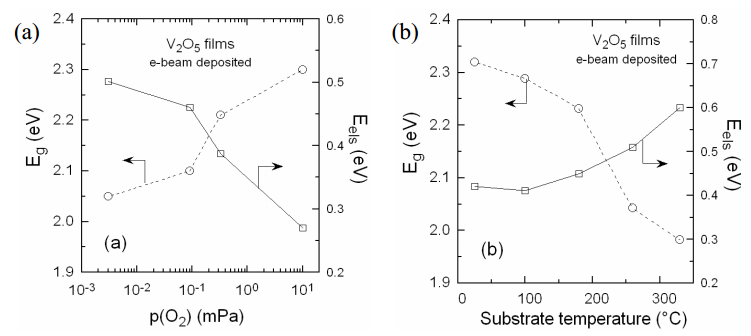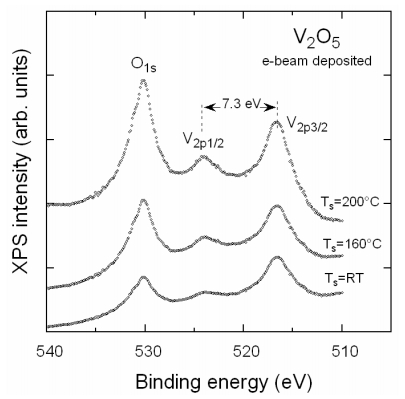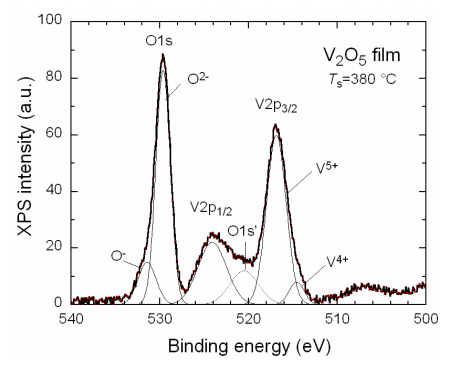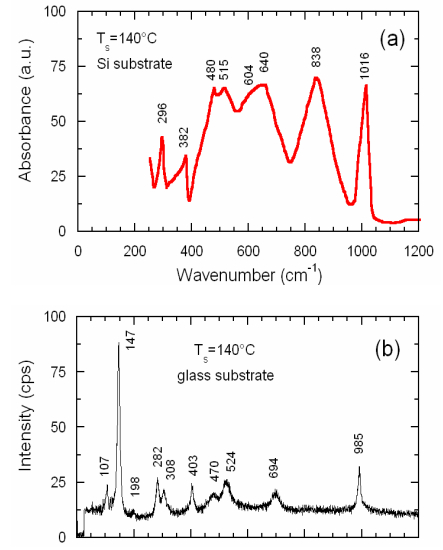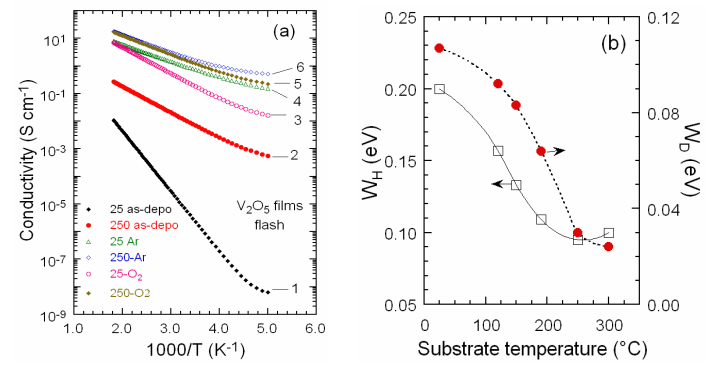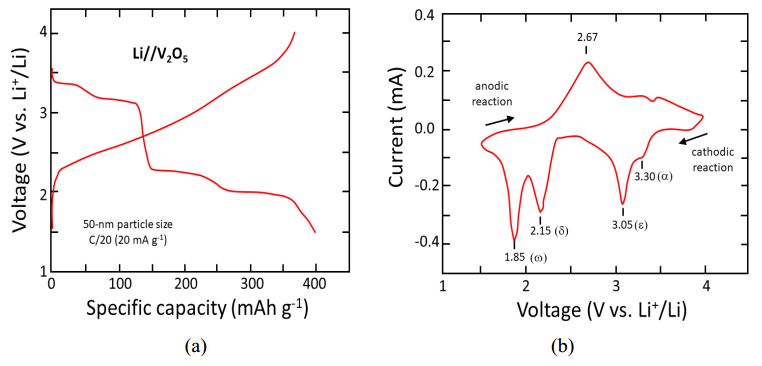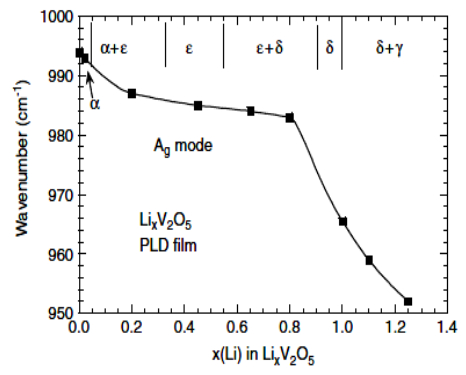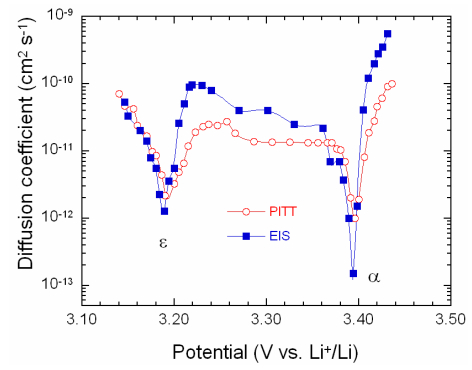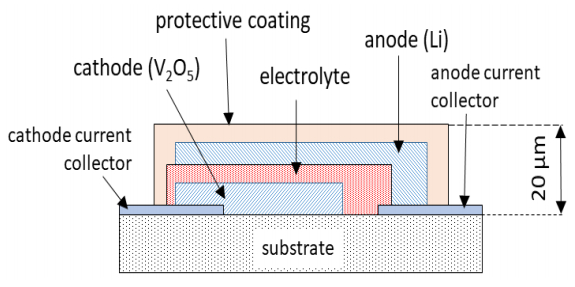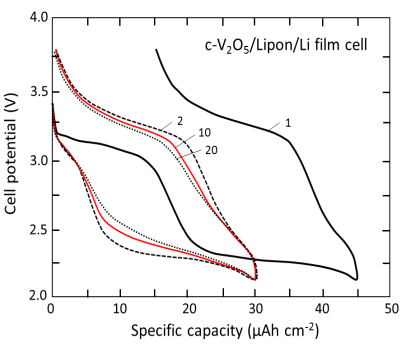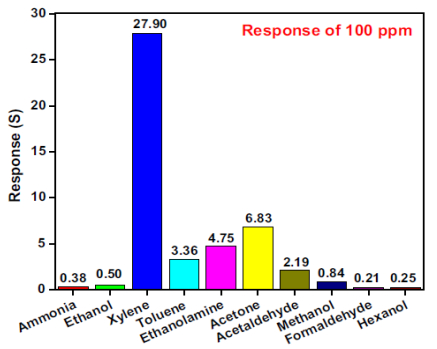|
[1]
|
Roscoe HE (1868) XXXVI.—Researches on vanadium. J Chem Soc 21: 322–350. doi: 10.1039/JS8682100322

|
|
[2]
|
Ditte A (1885) Recherches sur le vanadium, propriétés de l'acide vanadique. C R Acad Sci Paris 101: 698–702.
|
|
[3]
|
Hugues JM, Finger LW (1983) The crystal chemistry of shcherbinaite, naturally occurring V2O5. Am Mineral 68: 1220–1222.
|
|
[4]
|
Ketelaar JAA (1936) Crystal structure and shape of colloidal particles of vanadium pentoxide. Nature 137: 316.
|
|
[5]
|
Byström A, Wilhelmi KA, Brotzen O (1950) Vanadium pentoxide—a compound with five-coordinated vanadium atoms. Acta Chem Scand 4: 1119–1130. doi: 10.3891/acta.chem.scand.04-1119

|
|
[6]
|
Bachmann HG, Ahmed FR, Barnes WH (1961) The crystal structure of vanadium pentoxide. Z Krist -Cryst Mater 115: 110–131.
|
|
[7]
|
Enjalbert R, Galy J (1986) A refinement of the structure of V2O5. Acta Crystallogr C 42: 1467–1469. doi: 10.1107/S0108270186091825

|
|
[8]
|
Ramana CV, Hussain OM, Srinivasulu-Naidu B, et al. (1997) Spectroscopic characterization of electron-beam evaporated V2O5 thin films. Thin Solid Films 305: 219–226. doi: 10.1016/S0040-6090(97)00141-7

|
|
[9]
|
Julien C, Guesdon JP, Gorenstein A, et al. (1995) The influence of the substrate material on the growth of V2O5 flash-evaporated films. Appl Surf Sci 90: 389–391.
|
|
[10]
|
Balog P, Orosel D, Cancarevic Z, et al. (2007) V2O5 phase diagram revisited at high pressures and high temperatures. J Alloy Compd 429: 87–98. doi: 10.1016/j.jallcom.2006.04.042

|
|
[11]
|
Parija A, Prendergast D, Banerjee S (2017) Evaluation of multivalent cation insertion in single- and double-layered polymorphs of V2O5. ACS Appl Mater Inter 9: 23756–23765. doi: 10.1021/acsami.7b05556

|
|
[12]
|
Bates JB, Dudney NJ, Lubben DC, et al. (1995) Thin-film rechargeable lithium batteries. J Power Sources 54: 58–62. doi: 10.1016/0378-7753(94)02040-A

|
|
[13]
|
Julien C, Gorenstein A (1995) Materials design and optimization for thin-film microbatteries. Ionics 1: 193–210. doi: 10.1007/BF02426018

|
|
[14]
|
Julien C (1996) Technology of microbatteries and its applications, In: Radhakrishna S, Trends in Materials Science, New Delhi: Narosa Publ. House, 24–43.
|
|
[15]
|
Julien C (2000) Lithium microbatteries, In: Julien C, Stoynov Z, Materials for lithium-ion batteries, Amsterdam: Kluwer Acad Publ., 381–400.
|
|
[16]
|
Lampert CM (1998) Smart switchable glazing for solar energy and daylight control. Sol Energ Mat Sol C 52: 207–221. doi: 10.1016/S0927-0248(97)00279-1

|
|
[17]
|
Prakash NG, Dhananjaya M, Reddy BP, et al. (2016) Molybdenum doped V2O5 thin films electrodes for supercapacitors. Mater Today Proc 3: 4076–4081. doi: 10.1016/j.matpr.2016.11.076

|
|
[18]
|
Vernardou D, Sapountzis A, Spanakis E, et al. (2013) Electrochemical activity of electrodeposited V2O5 coatings. J Electrochem Soc 160: D6–D9. doi: 10.1149/2.043304jes

|
|
[19]
|
Lin YS, Tsai CW (2008) Reactive sputtering deposition of V2O5−z on flexible PET/ITO substrates for electrochromic devices. Surf Coat Tech 202: 5641–5645. doi: 10.1016/j.surfcoat.2008.06.037

|
|
[20]
|
Ma X, Lu S, Wan F, et al. (2016) Synthesis and electrochromic characterization of graphene/V2O5/MoO3 nanocomposite films. ECS J Solid State Sc 5: P572–P577. doi: 10.1149/2.0031610jss

|
|
[21]
|
Vernardou D, Loudoudakis D, Spanakis E, et al. (2014) Electrochemical properties of vanadium oxide coatings grown by hydrothermal synthesis on FTO substrates. New J Chem 38: 1959–1964. doi: 10.1039/C3NJ00931A

|
|
[22]
|
Mjejri I, Manceriu LM, Gaudon M, et al. (2016) Nano-vanadium pentoxide films for electrochromic displays. Solid State Ionics 292: 8–14. doi: 10.1016/j.ssi.2016.04.023

|
|
[23]
|
Beke S (2011) A review of the growth of V2O5 films from 1885 to 2010. Thin Solid Films 519: 1761–1771. doi: 10.1016/j.tsf.2010.11.001

|
|
[24]
|
Rao MC, Rao RK (2014) Thermal evaporated V2O5 thin films: thermodynamic properties. Int J Chem Tech Res 6: 3931–3934.
|
|
[25]
|
Chakraborty S, Sakata H, Yokoyama E, et al. (2007) Laser induced forward transfer technique for maskless patterning of amorphous V2O5 thin films. Appl Surf Sci 254: 638–643. doi: 10.1016/j.apsusc.2007.06.066

|
|
[26]
|
Kumar RTR, Karunagaran B, Venkatachalam S, et al. (2003) Influence of deposition temperature on the growth of vacuum evaporated V2O5 thin films. Mater Lett 57: 3820–3825. doi: 10.1016/S0167-577X(03)00185-X

|
|
[27]
|
Dhananjaya M, Prakash NG, Sandhya GL, et al. (2017) Microstructure and supercapacitor properties of V2O5 thin film prepared by thermal evaporation method. Mech Mater Sci Eng.
|
|
[28]
|
Santos R, Loureiro J, Nogueira A, et al. (2013) Thermoelectric properties of V2O5 thin films deposited by thermal evaporation. Appl Surf Sci 282: 590–594. doi: 10.1016/j.apsusc.2013.06.016

|
|
[29]
|
Julien C, Khelfa A, Benramdane N, et al. (1994) Lithium insertion in indium selenide films: application to microbatteries. Mater Sci Eng B-Adv 23: 105–115. doi: 10.1016/0921-5107(94)90342-5

|
|
[30]
|
Julien C, Guesdon JP, Gorenstein A, et al. (1995) The growth of V2O5 flash-evaporated films. J Mater Sci Lett 14: 934–936. doi: 10.1007/BF02427469

|
|
[31]
|
Murawski L, Gledel C, Sanchez C, et al. (1987) Electrical conductivity of V2O5 and LixV2O5 amorphous thin films. J Non-Cryst Solids 89: 98–106. doi: 10.1016/S0022-3093(87)80324-1

|
|
[32]
|
Ramana CV, Hussain OM, Naidu BS, et al. (1998) Physical investigations on electron-beam evaporated vanadium pentoxide films. Mater Sci Eng B-Adv 52: 32–39. doi: 10.1016/S0921-5107(97)00273-0

|
|
[33]
|
Vernardou D (2017) Using an atmospheric pressure chemical vapor deposition process for the development of V2O5 as an electrochromic material. Coatings 7: 24. doi: 10.3390/coatings7020024

|
|
[34]
|
Mantoux A, Groult H, Balnois E, et al. (2004) Vanadium oxide films synthesized by CVD and used as positive electrodes in secondary lithium batteries. J Electrochem Soc 151: A368–A373. doi: 10.1149/1.1641037

|
|
[35]
|
Groult H, Le Van K, Mantoux A, et al. (2007) Study of the Li+ insertion into V2O5 films deposited by CVD onto various substrates. J Power Sources 174: 312–320. doi: 10.1016/j.jpowsour.2007.09.045

|
|
[36]
|
Barreca D, Armelao L, Caccavale F, et al. (2000) Highly oriented V2O5 nanocrystalline thin films by plasma-enhanced chemical vapor deposition. Chem Mater 12: 98–103. doi: 10.1021/cm991095a

|
|
[37]
|
Watanabe H, Itoh K, Matsumoto O (2001) Properties of V2O5 thin films deposited by means of plasma MOCVD. Thin Solid Films 386: 281–285. doi: 10.1016/S0040-6090(00)01674-6

|
|
[38]
|
Barreca D, Battiston GA, Caccavalec F, et al. (1999) A PE-MOCVD route to V2O5 nanostructured thin films. J Phys IV France 9: 529–536.
|
|
[39]
|
Crociani L, Carta G, Natali M, et al. (2011) MOCVD of vanadium oxide films with a novel vanadium(III) precursor. Chem Vapor Depos 17: 6–8. doi: 10.1002/cvde.201004291

|
|
[40]
|
Sahana MB, Shivashankar SA (2004) Metalorganic chemical vapor deposition of highly oriented thin film composites of V2O5 and V6O13: suppression of the metal-semiconductor transition in V6O13. J Mater Res 19: 2859–2870. doi: 10.1557/JMR.2004.0394

|
|
[41]
|
Robbins J, Seman M (2005) Electrochromic devices deposited on low-temperature plastics by plasma-enhanced chemical vapor deposition. United States: USDOE Office of Energy Efficiency and Renewable Energy (EERE), Report No.: FG36-04GO14328.
|
|
[42]
|
Nandakumar NK, Seebauer EG (2011) Low temperature chemical vapor deposition of nanocrystalline V2O5 thin films. Thin Solid Films 519: 3663–3668. doi: 10.1016/j.tsf.2011.02.002

|
|
[43]
|
Koike S, Fujieda T, Sakai T, et al. (1999) Characterization of sputtered vanadium oxide films for lithium batteries. J Power Sources 81–82: 581–584.
|
|
[44]
|
Batista C, Teixeira V, Carneiro J (2008) Structural and morphological characterization of magnetron sputtered nanocrystalline vanadium oxide films for thermochromic smart surfaces. J Nano Res 2: 21–30. doi: 10.4028/www.scientific.net/JNanoR.2.21

|
|
[45]
|
Quinzeni I, Ferrari S, Quartarone E, et al. (2011) Structural, morphological and electrochemical properties of nanocrystalline V2O5 thin films deposited by means of radiofrequency magnetron sputtering. J Power Sources 196: 10228–10233. doi: 10.1016/j.jpowsour.2011.08.073

|
|
[46]
|
Giannetta HMR, Calaza C, Lamas DG, et al. (2015) Electrical transport properties of V2O5 thin films obtained by thermal annealing of layers grown by RF magnetron sputtering at room temperature. Thin Solid Films 589: 730–734. doi: 10.1016/j.tsf.2015.06.048

|
|
[47]
|
Poelman H, Tomaszewski H, Poelman D, et al. (2002) V2O5 thin films deposited by means of dc magnetron sputtering from ceramic V2O3 targets. Surf Interface Anal 34: 724–727. doi: 10.1002/sia.1397

|
|
[48]
|
Su Q, Lan W, Wang YY, et al. (2009) Structural characterization of β-V2O5 films prepared by dc reactive magnetron sputtering. Appl Surf Sci 255: 4177–4179. doi: 10.1016/j.apsusc.2008.11.002

|
|
[49]
|
Fateh N, Fontalvo GA, Mitterer C (2007) Structural and mechanical properties of dc and pulsed dc reactive magnetron sputtered V2O5 films. J Phys D Appl Phys 40: 7716–7719. doi: 10.1088/0022-3727/40/24/019

|
|
[50]
|
Gallasch T, Stockhoff T, Baither D, et al. (2011) Ion beam sputter deposition of V2O5 thin films. J Power Sources 196: 428–435. doi: 10.1016/j.jpowsour.2010.06.099

|
|
[51]
|
Silversmit G, Poelman H, DeGryse R (2004) Influence of magnetron deposition parameters on the stoichiometry of sputtered V2O5 films. Surf Interface Anal 36: 1163–1166. doi: 10.1002/sia.1866

|
|
[52]
|
De Castro MSB, Ferreira CL, de Avillez RR (2013) Vanadium oxide thin films produced by magnetron sputtering from a V2O5 target at room temperature. Infrared Phys Techn 60: 103–107. doi: 10.1016/j.infrared.2013.03.001

|
|
[53]
|
Raj PD, Gupta S, Sridharan M (2015) Nanostructured V2O5 thin films deposited at low sputtering power. Mat Sci Semicon Proc 39: 426–432. doi: 10.1016/j.mssp.2015.04.054

|
|
[54]
|
Fateh N, Fontalvo GA, Cha L, et al. (2008) Synthesis-structure relations for reactive magnetron sputtered V2O5 films. Surf Coat Tech 202: 1551–1555. doi: 10.1016/j.surfcoat.2007.07.010

|
|
[55]
|
Lourenço A, Gorenstein A, Passerini S, et al. (1998) Radio-frequency reactively sputtered VOx thin films deposited at different oxygen flows. J Electrochem Soc 145: 706–711. doi: 10.1149/1.1838327

|
|
[56]
|
Benmoussa M, Ibnouelghazi E, Bennouna A, et al. (1995) Structural, electrical and optical properties of sputtered vanadium pentoxide thin films. Thin Solid Films 265: 22–28. doi: 10.1016/0040-6090(95)06617-9

|
|
[57]
|
Benmoussa M, Outzourhit A, Bennouna A, et al. (2002) Electrochromism in sputtered V2O5 thin films: structural and optical studies. Thin Solid Films 405: 11–16. doi: 10.1016/S0040-6090(01)01734-5

|
|
[58]
|
Yoon YS, Kim JS, Choi SH (2004) Structural and electrochemical properties of vanadium oxide thin films grown by d.c. and r.f. reactive sputtering at room temperature. Thin Solid Films 460: 41–47.
|
|
[59]
|
Ottaviano L, Pennisi A, Simone F, et al. (2004) RF sputtered electrochromic V2O5 films. Opt Mater 27: 307–313. doi: 10.1016/j.optmat.2004.04.001

|
|
[60]
|
Lin YS, Tsai CW, Chen PW (2008) Electrochromic properties of V2O5−z thin films sputtered onto flexible PE/ITO substrates. Solid State Ionics 179: 290–297. doi: 10.1016/j.ssi.2008.01.054

|
|
[61]
|
Kang M, Chu M, Kim SW, et al. (2013) Optical and electrical properties of V2O5 nanorod films grown using an electron beam. Thin Solid Films 547: 198–201. doi: 10.1016/j.tsf.2013.03.060

|
|
[62]
|
Zhang JG, McGraw JM, Turner J, et al. (1997) Charging capacity and cycling stability of VOx films prepared by pulsed laser deposition. J Electrochem Soc 144: 1630–1634. doi: 10.1149/1.1837652

|
|
[63]
|
Julien C, Haro-Poniatowski E, Camacho-Lopez MA, et al. (1999) Growth of V2O5 thin films by pulsed laser deposition and their applications in lithium microbatteries. Mater Sci Eng B-Adv 65: 170–176. doi: 10.1016/S0921-5107(99)00187-7

|
|
[64]
|
Ramana CV, Smith RJ, Hussain OM, et al. (2004) On the growth mechanism of pulsed-laser deposited vanadium oxide thin films. Mater Sci Eng B-Adv 111: 218–225. doi: 10.1016/j.mseb.2004.04.017

|
|
[65]
|
Iida Y, Kaneko Y, Kanno Y (2008) Fabrication of pulsed-laser deposited V2O5 thin films for electrochromic devices. J Mater Process Tech 197: 261–267. doi: 10.1016/j.jmatprotec.2007.06.032

|
|
[66]
|
Iida Y, Kanno Y (2009) Doping effect of M (M = Nb, Ce, Nd, Dy, Sm, Ag, and/or Na) on the growth of pulsed-laser deposited V2O5 thin films. J Mater Process Tech 209: 2421–2427. doi: 10.1016/j.jmatprotec.2008.05.033

|
|
[67]
|
McGraw JM, Perkins JD, Hasoon F, et al. (2000) Pulsed laser deposition of oriented V2O5 thin films. J Mater Res 15: 2249–2265. doi: 10.1557/JMR.2000.0323

|
|
[68]
|
Ashrafi MA, Ranjbar M, Kalhori H, et al. (2017) Pulsed laser deposition of Mo–V–O thin films for chromogenic applications. Thin Solid Films 621: 220–228. doi: 10.1016/j.tsf.2016.11.041

|
|
[69]
|
Madhuri KV, Rao KS, Naidu BS, et al. (2002) Characterization of laser ablated V2O5 thin films. J Mater Sci-Mater El 13: 426–432.
|
|
[70]
|
Huotari J, Bjorklund R, Lappalainen J, et al. (2015) Pulsed laser deposited nanostructured vanadium oxide thin films characterized as ammonia sensors. Sensor Actuat B-Chem 217: 22–29. doi: 10.1016/j.snb.2015.02.089

|
|
[71]
|
Ramana CV, Smith RJ, Hussain OM, et al. (2005) Surface analysis of pulsed laser-deposited V2O5 thin films and their lithium intercalated products studied by Raman spectroscopy. Surf Interface Anal 37: 406–411. doi: 10.1002/sia.2018

|
|
[72]
|
Ramana CV, Smith RJ, Hussain OM (2003) Grain size effects on the optical characteristics of pulsed-laser deposited vanadium oxide thin films. Phys Status Solidi A 199: R4–R6. doi: 10.1002/pssa.200309009

|
|
[73]
|
Beke S, Giorgio S, Korosi L, et al. (2008) Structural and optical properties of pulsed laser deposited V2O5 thin films. Thin Solid Films 516: 4659–4664. doi: 10.1016/j.tsf.2007.08.113

|
|
[74]
|
Fang GJ, Liu ZL, Wang YQ, et al. (2000) Orientated growth of V2O5 electrochromic thin films on transparent conductive glass by pulsed excimer laser ablation technique. J Phys D Appl Phys 33: 3018–3021. doi: 10.1088/0022-3727/33/23/302

|
|
[75]
|
Ramana CV, Hussain OM, Pinto R, et al. (2003) Microstructural features of pulsed-laser deposited V2O5 thin films. Appl Surf Sci 207: 135–138. doi: 10.1016/S0169-4332(02)01411-3

|
|
[76]
|
Ramana CV, Smith RJ, Hussain OM, et al. (2004) Growth and surface characterization of V2O5 thin films made by pulsed laser deposition. J Vac Sci Technol A 22: 2453–2458. doi: 10.1116/1.1809123

|
|
[77]
|
Ramana CV, Hussain OM, Naidu BS, et al. (1997) Influence of substrate temperature on the composition and structural properties of electron beam evaporated V2O5 thin films. Vacuum 48: 431–434. doi: 10.1016/S0042-207X(96)00304-1

|
|
[78]
|
Ramana CV, Hussain OM (1997) Optical absorption behaviour of vanadium pentoxide thin films. Adv Funct Mater 7: 225–231.
|
|
[79]
|
Ramana CV, Hussain OM, Naidu BS, et al. (1998) Physical investigations on electron-beam evaporated vanadium pentoxide films. Mater Sci Eng B-Adv 52: 32–39. doi: 10.1016/S0921-5107(97)00273-0

|
|
[80]
|
Ramana CV, Hussain OM, Naidu BS (1997) Growth and structure of electron beam evaporated V2O5 thin films. Mater Chem Phys 50: 195–199. doi: 10.1016/S0254-0584(97)01914-7

|
|
[81]
|
Ramana CV, Hussain OM, Uthanna S, et al. (1998) Influence of oxygen partial pressure on the optical properties of electron beam evaporated vanadium pentoxide thin films. Opt Mater 10: 101–107. doi: 10.1016/S0925-3467(97)00168-7

|
|
[82]
|
Kumar A, Singh P, Kulkarni N, et al. (2008) Structural and optical studies of nanocrystalline V2O5 thin films. Thin Solid Films 516: 912–918. doi: 10.1016/j.tsf.2007.04.165

|
|
[83]
|
Rosaiah P, Sandhya GL, Suresh S, et al. (2016) Effect of substrate temperature on micro-structural, optical and electrical properties of V2O5 thin films. Adv Mater Proc 1: 215–219. doi: 10.5185/amp.2016/219

|
|
[84]
|
Thiagarajan S, Thaiyan M, Ganesan R (2015) Physical property exploration of highly oriented V2O5 thin films prepared by electron beam evaporation. New J Chem 39: 9471–9479. doi: 10.1039/C5NJ01582K

|
|
[85]
|
Ali HM, Abdel-Kakeem AM (2010) Structural and optical properties of electron-beam evaporated Al2O3-doped V2O5 thin films for various applications. Phys Status Solidi A 207: 132–138. doi: 10.1002/pssa.200925121

|
|
[86]
|
Bouzidi A, Benramdane N, Nakrela A, et al. (2002) First synthesis of vanadium oxide thin films by spray pyrolysis technique. Mater Sci Eng B-Adv 95: 141–147. doi: 10.1016/S0921-5107(02)00224-6

|
|
[87]
|
Boudaoud L, Benramdane N, Desfeux R, et al. (2006) Structural and optical properties of MoO3 and V2O5 thin films prepared by spray pyrolysis. Catal Today 113: 230–234. doi: 10.1016/j.cattod.2005.11.072

|
|
[88]
|
Varadaraajana V, Satishkumara BC, Nandab J, et al. (2011) Direct synthesis of nanostructured V2O5 films using solution plasma spray approach for lithium battery applications. J Power Sources 196: 10704–10711. doi: 10.1016/j.jpowsour.2011.09.016

|
|
[89]
|
Irani R, Rozati SM, Beke S (2013) Structural and optical properties of nanostructural V2O5 thin films deposited by spray pyrolysis technique: effect of the substrate temperature. Mater Chem Phys 139: 489–493. doi: 10.1016/j.matchemphys.2013.01.046

|
|
[90]
|
Wei Y, Li M, Zheng J, et al. (2013) Structural characterization and electrical and optical properties of V2O5 films prepared via ultrasonic spraying. Thin Solid Films 534: 446–451. doi: 10.1016/j.tsf.2013.01.093

|
|
[91]
|
Abd-Alghafour NM, Ahmed NM, Hassan Z, et al. (2016) Influence of solution deposition rate on properties of V2O5 thin films deposited by spray pyrolysis technique. AIP Conf Proc 1756: 090010. doi: 10.1063/1.4958791

|
|
[92]
|
Vijayakumar Y, Kumar-Mani G, Ramana-Reddy MV, et al. (2015) Nanostructured flower like V2O5 thin films and its room temperature sensing characteristics. Ceram Int 41: 2221–2227. doi: 10.1016/j.ceramint.2014.10.023

|
|
[93]
|
Nazemiyan M, Jalili S (2013) Record low temperature Mo doped V2O5 thermochromic thin films for optoelectronic applications. AIP Adv 3: 112103. doi: 10.1063/1.4829663

|
|
[94]
|
Akl AA (2006) Effect of solution molarity on the characteristics of vanadium pentoxide thin films. Appl Surf Sci 252: 8745–8750. doi: 10.1016/j.apsusc.2005.12.076

|
|
[95]
|
Wang J, Curtis CJ, Schulz DL, et al. (2004) Influences of treatment temperature and water content on capacity and rechargeability of V2O5 xerogel films. J Electrochem Soc 151: A1–A7. doi: 10.1149/1.1627342

|
|
[96]
|
Najdoski M, Koleva V, Samet A (2014) Effect of deposition conditions on the electrochromic properties of nanostructured thin films of ammonium intercalated vanadium pentoxide xerogel. J Phys Chem C 118: 9636–9646. doi: 10.1021/jp4127122

|
|
[97]
|
Chen Y, Xie K, Liu Z (1998) XPS studies of V2O5 thin film at different temperatures and oxygen partial pressures. Appl Surf Sci 126: 347–351. doi: 10.1016/S0169-4332(97)00791-5

|
|
[98]
|
Wang Y, Shang H, Chou T, et al. (2005) Effects of thermal annealing on the Li+ intercalation properties of V2O5·nH2O xerogel films. J Phys Chem B 109: 11361–11366.
|
|
[99]
|
Cazzanelli E, Mariotto G, Passerini S, et al. (1996) Raman spectroscopic investigations of Li-intercalated V2O5 xerogel. J Non-Cryst Solids 208: 89–98. doi: 10.1016/S0022-3093(96)00507-8

|
|
[100]
|
Gokdemir FP, Ozdemir O, Kutlu K (2014) Comparison of structural and electrochemical properties of V2O5 thin films prepared by organic/inorganic precursors. Electrochim Acta 121: 240–244. doi: 10.1016/j.electacta.2013.12.164

|
|
[101]
|
Raj DV, Ponpandian N, Mangalaraj M, et al. (2013) Effect of annealing and electrochemical properties of sol-gel dip coated nanocrystalline V2O5 thin films. Mat Sci Semicon Proc 16: 256–262. doi: 10.1016/j.mssp.2012.11.001

|
|
[102]
|
Wang Y, Cao G (2006) Li+-intercalation electrochemical/electrochromic properties of vanadium pentoxide films by sol electrophoretic deposition. Electrochim Acta 51: 4865–4872. doi: 10.1016/j.electacta.2006.01.026

|
|
[103]
|
Kim KH, Roh DK, Song IK, et al. (2010) Enhanced performance as a lithium ion battery cathode of electrodeposited V2O5 thin films by e-beam irradiation. J Solid State Electr 14: 1801–1805. doi: 10.1007/s10008-010-1114-9

|
|
[104]
|
Liu Y, Clark M, Zhang Q, et al. (2011) V2O5 nano-electrodes with high power and energy densities for thin film Li-ion batteries. Adv Energy Mater 1: 194–202. doi: 10.1002/aenm.201000037

|
|
[105]
|
Groult H, Balnois E, Mantoux A, et al. (2006) Two-dimensional recrystallisation processes of nanometric vanadium oxide thin films grown by atomic layer chemical vapor deposition (ALCVD) evidenced by AFM. Appl Surf Sci 252: 5917–5925. doi: 10.1016/j.apsusc.2005.08.014

|
|
[106]
|
Lantelme F, Mantoux A, Groult H, et al. (2002) Analysis of a phase transition process controlled by diffusion, application to lithium insertion into V2O5. Electrochim Acta 47: 3927–3938. doi: 10.1016/S0013-4686(02)00364-X

|
|
[107]
|
Keränen J, Auroux A, Ek S, et al. (2002) Preparation, characterization and activity testing of vanadia catalysts deposited onto silica and alumina supports by atomic layer deposition. Appl Catal A-Gen 228: 213–225. doi: 10.1016/S0926-860X(01)00975-9

|
|
[108]
|
Le Van K, Groult H, Mantoux A, et al. (2006) Amorphous vanadium oxide films synthesized by ALCVD for lithium rechargeable batteries. J Power Sources 160: 592–601. doi: 10.1016/j.jpowsour.2006.01.049

|
|
[109]
|
Musschoot J, Deduytsche D, Poelman H, et al. (2009) Comparison of thermal and plasma-enhanced ALD/CVD of vanadium pentoxide. J Electrochem Soc 156: P122–P126. doi: 10.1149/1.3133169

|
|
[110]
|
Badot J, Ribes S, Yousfi E, et al. (2000) Atomic layer epitaxy of vanadium oxide thin films and electrochemical behavior in presence of lithium ions. Electrochem Solid St 3: 485–488.
|
|
[111]
|
Chen X, Pomerantseva E, Banerjee P, et al. (2012) Ozone-based atomic layer deposition of crystalline V2O5 films for high performance electrochemical energy storage. Chem Mater 24: 1255–1261. doi: 10.1021/cm202901z

|
|
[112]
|
Badot JC, Mantoux A, Baffier N, et al. (2004) Electrical properties of V2O5 thin films obtained by atomic layer deposition (ALD). J Mater Chem 14: 3411–3415. doi: 10.1039/b410324f

|
|
[113]
|
Ostreng E, Gandrud KB, Hu Y, et al. (2014) High power nano-structured V2O5 thin film cathodes by atomic layer deposition. J Mater Chem A 2: 15044–15051. doi: 10.1039/C4TA00694A

|
|
[114]
|
Chen X, Pomerantseva E, Gregorczyk K, et al. (2013) Cathodic ALD V2O5 thin films for high-rate electrochemical energy storage. RSC Adv 3: 4294–4302. doi: 10.1039/c3ra23031g

|
|
[115]
|
Blanquart T, Niinisto J, Gavagnin M, et al. (2013) Atomic layer deposition and characterization of vanadium oxide thin films. RSC Adv 3: 1179–1185. doi: 10.1039/C2RA22820C

|
|
[116]
|
Daubert JS, Lewis NP, Gotsch HN, et al. (2015) Effect of meso- and micro-porosity in carbon electrodes on atomic layer deposition of pseudocapacitive V2O5 for high performance supercapacitors. Chem Mater 27: 6524–6534. doi: 10.1021/acs.chemmater.5b01602

|
|
[117]
|
Santos L, Swiatowska J, Lair V, et al. (2017) Mechanisms of enhanced lithium intercalation into thin film V2O5 in ionic liquids investigated by X-ray photoelectron spectroscopy and time-of-flight secondary ion mass spectroscopy. J Power Sources 364: 61–71. doi: 10.1016/j.jpowsour.2017.08.003

|
|
[118]
|
Wang X, Guo Z, Gao Y, et al. (2017) Atomic layer deposition of vanadium oxide thin films from tetrakis(dimethylamino)vanadium precursor. J Mater Res 32: 37–44. doi: 10.1557/jmr.2016.303

|
|
[119]
|
Sreedhara MB, Ghatak J, Bharath B, et al. (2017) Atomic layer deposition of ultrathin crystalline epitaxial films of V2O5. ACS Appl Mater Inter 9: 3178–3185.
|
|
[120]
|
Chain EE (1991) Optical properties of vanadium dioxide and vanadium pentoxide thin films. Appl Optics 30: 2782–2787. doi: 10.1364/AO.30.002782

|
|
[121]
|
Cezar AB, Graff IL, Varalda J, et al. (2014) Oxygen-vacancy-induced room-temperature magnetization in lamellar V2O5 thin films. J Appl Phys 116: 163904. doi: 10.1063/1.4899249

|
|
[122]
|
Ranea VA, Dammig-Quina PL (2016) The structure of the bulk and the (001) surface of V2O5. A DFT + U study. Mater Res Express 3: 085005. doi: 10.1088/2053-1591/3/8/085005

|
|
[123]
|
Chakrabarti A, Hermann K, Druzinic R, et al. (1999) Geometric and electronic structure of vanadium pentoxide: a density functional bulk and surface study. Phys Rev B 59: 10583–10590. doi: 10.1103/PhysRevB.59.10583

|
|
[124]
|
Eyert V, Hck KH (1998) Electronic structure of V2O5: role of octahedral deformations. Phys Rev B 57: 12727–12737. doi: 10.1103/PhysRevB.57.12727

|
|
[125]
|
Audière JP, Madi A, Grenet JC (1982) Electrical and thermal properties of highly quenched amorphous V2O5 thin films. J Mater Sci 17: 2973–2978. doi: 10.1007/BF00644678

|
|
[126]
|
Kumagai N, Kitamoto H, Baba M, et al. (1998) Intercalation of lithium in rf-sputtered vanadium oxide film as an electrode material for lithium-ion batteries. J Appl Electrochem 28: 41–48.
|
|
[127]
|
Benmoussa M, Outzourhit A, Jourdani R, et al. (2003) Structural, optical and electrochromic properties of sol-gel V2O5 thin films. Active Passive Electron Comp 26: 245–256. doi: 10.1080/0882751031000116223

|
|
[128]
|
Losurdo M, Barreca D, Bruno G, et al. (2001) Spectroscopic ellipsometry investigation of V2O5 nanocrystalline thin films. Thin Solid Films 384: 58–64. doi: 10.1016/S0040-6090(00)01820-4

|
|
[129]
|
Vernardou D, Paterakis P, Drosos H, et al. (2011) A study of the electrochemical performance of vanadium oxide thin films grown by atmospheric pressure chemical vapour deposition. Sol Energ Mat Sol C 95: 2842–2847. doi: 10.1016/j.solmat.2011.05.046

|
|
[130]
|
Guimond S, Sturm JM, Göbke D, et al. (2008) Well-ordered V2O5(001) thin films on Au(111): growth and thermal stability. J Phys Chem C 112: 11835–11846. doi: 10.1021/jp8011156

|
|
[131]
|
Szörényi T, Bali K, Hevesi I (1980) Structural characterization of amorphous vanadium pentoxide thin films prepared by chemical vapour deposition. J Non-Cryst Solids 35–36: 1245–1248.
|
|
[132]
|
Özer N (1997) Electrochemical properties of sol-gel deposited vanadium pentoxide films. Thin Solid Films 305: 80–87. doi: 10.1016/S0040-6090(97)00086-2

|
|
[133]
|
Kumar RTR, Karunagaran B, Kumar VS, et al. (2003) Structural properties of V2O5 thin films prepared by vacuum evaporation. Mat Sci Semicon Proc 6: 543–546. doi: 10.1016/j.mssp.2003.08.017

|
|
[134]
|
Gilles E, Boesman E (1966) EPR studies of V2O5 single crystals. I. Defect centres in pure, non-stoichiometric vanadium pentoxide. Phys Stat Solidi B 14: 337–347.
|
|
[135]
|
Pozarnsky G, Wright L, McCormijk A (1994) Effects of aging time on V2O5 sol-gel coatings. J Sol-Gel Sci Techn 3: 57–62. doi: 10.1007/BF00490149

|
|
[136]
|
Senapati S, Panda S (2016) Effect of aging of V2O5 sol on properties of nanoscale films. Thin Solid Films 599: 42–48. doi: 10.1016/j.tsf.2015.12.045

|
|
[137]
|
Anaissi FJ, Demets GJF, Alvarez EB, et al. (2001) Long-term aging of vanadium(V) oxide xerogel precursor solutions: structural and electrochemical implications. Electrochim Acta 47: 441–450. doi: 10.1016/S0013-4686(01)00737-X

|
|
[138]
|
Hirashima H, Gengyo M, Kojima C, et al. (1995) Effects of aging and drying on structure of V2O5 gels. J Non-Cryst Solids 186: 54–58. doi: 10.1016/0022-3093(95)00033-X

|
|
[139]
|
Talledo A, Granqvist CG (1995) Electrochromic vanadium-pentoxide-based films: structural, electrochemical and optical properties. J Appl Phys 77: 4655–4666. doi: 10.1063/1.359433

|
|
[140]
|
Luksich J, Aita CH (1991) Annealing response of disordered sputter deposited vanadium pentoxide (V2O5). J Vac Sci Technol A 9: 542–546. doi: 10.1116/1.577405

|
|
[141]
|
Song GY, Oh C, Sinha S, et al. (2017) Facile phase control of multivalent vanadium oxide tin films (V2O5 and VO2) by atomic layer deposition and postdeposition annealing. ACS Appl Mater Inter 9: 23909–23917. doi: 10.1021/acsami.7b03398

|
|
[142]
|
Luo Z, Wu Z, Xu X, et al. (2010) Impact of substrate temperature on the microstructure, electrical and optical properties of sputtered nanoparticle V2O5 thin films. Vacuum 85: 145–150. doi: 10.1016/j.vacuum.2010.05.001

|
|
[143]
|
El Sound AMA, Mansour B, Soliman LI (1994) Optical and electrical properties of V2O5 thin films. Thin Solid Films 247: 140–143. doi: 10.1016/0040-6090(94)90487-1

|
|
[144]
|
Akl AA (2010) Thermal annealing effect on the crystallization and optical dispersion of sprayed V2O5 thin films. J Phys Chem Solids 71: 223–229. doi: 10.1016/j.jpcs.2009.11.009

|
|
[145]
|
Maki K, Fukuda T, Momose H, et al. (2012) Structural and optical properties of reactive-sputtered films of V2O5: measurement of optical bandgap and roughness correction. J Fac Sci Tech Seikei Univ 49: 41–44.
|
|
[146]
|
Atuchin VV, Ayupov BM, Kochubey VA, et al. (2008) Optical properties of textured V2O5/Si thin films deposited by reactive magnetron sputtering. Opt Mater 30: 1145–1148. doi: 10.1016/j.optmat.2007.05.040

|
|
[147]
|
Wu QH, Thissen A, Jaegermann W, et al. (2004) Photoelectron spectroscopy study of oxygen vacancy on vanadium oxides surface. Appl Surf Sci 236: 473–478. doi: 10.1016/j.apsusc.2004.05.112

|
|
[148]
|
Wu QH, Thißen A, Jaegerman W (2005) Photoelectron spectroscopic study of Li intercalation into V2O5 thin films. Surf Sci 578: 203–212. doi: 10.1016/j.susc.2005.01.042

|
|
[149]
|
Benayad A, Martinez H, Gies A, et al. (2006) Vanadium pentoxide thin films used as positive electrode in lithium microbatteries: an XPS study during cycling. J Phys Chem Solids 67: 1320–1324. doi: 10.1016/j.jpcs.2006.01.089

|
|
[150]
|
Swiatowska-Mrowiecka J, Martin F, Maurice V, et al. (2008) The distribution of lithium intercalated in V2O5 thin films studied by XPS and ToF-SIMS. Electrochim Acta 53: 4257–4266. doi: 10.1016/j.electacta.2007.12.083

|
|
[151]
|
Salvi AM, Guascito MR, DeBonis A, et al. (2003) Lithium intercalation on amorphous V2O5 thin film, obtained by r.f. deposition, using in situ sample transfer for XPS analysis. Surf Interface Anal 35: 897–905.
|
|
[152]
|
Ibris N, Salvi AM, Liberatore M, et al. (2005) XPS study of the Li intercalation process in sol-gel-produced V2O5 thin film: influence of substrate and film synthesis modification. Surf Interface Anal 37: 1092–1104. doi: 10.1002/sia.2084

|
|
[153]
|
Alamarguy D, Castle JE, Ibris N, et al. (2006) Characterization of sol-gel crystalline V2O5 thin films after Li intercalation cycling. Surf Interface Anal 38: 801–804. doi: 10.1002/sia.2138

|
|
[154]
|
Fleutot B, Martinez H, Pecquenard B, et al. (2008) Surface film morphology (AFM) and chemical features (XPS) of cycled V2O5 thin films in lithium microbatteries. J Power Sources 180: 836–844. doi: 10.1016/j.jpowsour.2008.02.080

|
|
[155]
|
Alamarguy D, Castle JE, Liberatore M, et al. (2006) Distribution of intercalated lithium in V2O5 thin films determined by SIMS depth profiling. Surf Interface Anal 38: 847–850. doi: 10.1002/sia.2139

|
|
[156]
|
Julien CM, Massot M (2003) Lattice vibrations of materials for lithium rechargeable batteries III. Lithium manganese oxides. Mater Sci Eng B-Adv 100: 69–78.
|
|
[157]
|
Julien CM, Massot M (2003) Lattice vibrations of materials for lithium rechargeable batteries I. Lithium manganese oxides. Mater Sci Eng B-Adv 97: 217–230.
|
|
[158]
|
Abello L, Husson E, Repelin Y, et al. (1983) Vibrational spectra and valence force field of crystalline V2O5. Spectrochim Acta A 39: 641–651. doi: 10.1016/0584-8539(83)80040-3

|
|
[159]
|
Baddour-Hadjean R, Pereira-Ramos JP, Navone C, et al. (2008) Raman microspectrometry study of electrochemical lithium intercalation into sputtered crystalline V2O5 thin films. Chem Mater 20: 1916–1923. doi: 10.1021/cm702979k

|
|
[160]
|
Surca A, Orel B, Drazic G, et al. (1999) Ex situ and in situ infrared spectroelectrochemical investigations of V2O5 crystalline films. J Electrochem Soc 146: 232–242. doi: 10.1149/1.1391592

|
|
[161]
|
Fang GJ, Liu ZL, Wang Y, et al. (2001) Synthesis and structural, electrochromic characterization of pulsed laser deposited vanadium oxide thin films. J Vac Sci Technol A 19: 887–892. doi: 10.1116/1.1359533

|
|
[162]
|
Su Q, Liu Q, Ma ML, et al. (2008) Raman spectroscopic characterization of the microstructure of V2O5 films. J Solid State Electr 12: 919–923. doi: 10.1007/s10008-008-0515-5

|
|
[163]
|
Lee SH, Cheong HM, Seong MJ, et al. (2002) Microstructure study of amorphous vanadium oxide thin films using Raman spectroscopy. J Appl Phys 92: 1893–1897. doi: 10.1063/1.1495074

|
|
[164]
|
Lee SH, Cheong HM, Seong MJ, et al. (2003) Raman spectroscopic studies of amorphous vanadium oxide thin films. Solid State Ionics 165: 111–116. doi: 10.1016/j.ssi.2003.08.022

|
|
[165]
|
Zhang Y, Liu YW, Cheng YS, et al. (2005) Electrochemical impedance spectra of V2O5 xerogel films with intercalation of lithium ion. J Cent South Univ T 12: 309–314. doi: 10.1007/s11771-005-0151-5

|
|
[166]
|
Julien C, Khelfa A, Guesdon JP, et al. (1996) Electrical properties of flash-evaporated V2O5 films. Ionics 2: 380–385. doi: 10.1007/BF02375816

|
|
[167]
|
Sanchez C, Livage J, Audiere JP, et al. (1984) Influence of the quenching rate on the properties of amorphous V2O5 thin films. J Non-Cryst Solids 65: 285–300. doi: 10.1016/0022-3093(84)90053-X

|
|
[168]
|
Mott NF (1968) Conduction in glasses containing transition metal ions. J Non-Crystal Solids 1: 1–17.
|
|
[169]
|
Akl AA (2007) Crystallization and electrical properties of V2O5 thin films prepared by RF sputtering. Appl Surf Sci 253: 7094–7099. doi: 10.1016/j.apsusc.2007.02.054

|
|
[170]
|
Wang HQ, Li N, Guldal NS, et al. (2012) Nanocrystal V2O5 thin film as hole-extraction layer in normal architecture organic solar cells. Org Electron 13: 3014–3021. doi: 10.1016/j.orgel.2012.08.007

|
|
[171]
|
Schneider K, Lubecka M, Czapla A (2016) V2O5 thin film for gas sensor applications. Sensor Actuat B-Chem 236: 970–977. doi: 10.1016/j.snb.2016.04.059

|
|
[172]
|
Park HK, Smyrl WH, Ward MD (1995) V2O5 xerogel films as intercalation hosts for lithium. J Electrochem Soc 142: 1068–1073. doi: 10.1149/1.2044133

|
|
[173]
|
Jourdani R, Jadoual L, Ait El Fqih M, et al. (2018) Effects of lithium insertion and deinsertion into V2O5 thin films: optical, structural and absorption properties. Surf Interface Anal 50: 52–58. doi: 10.1002/sia.6331

|
|
[174]
|
Julien C, Ivanov I, Gorenstein A (1995) Vibrational modifications on lithium intercalation in V2O5 films. Mater Sci Eng B-Adv 33: 168–172. doi: 10.1016/0921-5107(95)80032-8

|
|
[175]
|
Jung H, Gerasopoulos K, Talin AA, et al. (2017) A platform for in situ Raman and stress characterizations of V2O5 cathode using MEMS device. Electrochim Acta 242: 227–239. doi: 10.1016/j.electacta.2017.04.160

|
|
[176]
|
Surca A, Orel B (1999) IR spectroscopy of crystalline V2O5 films in different stages of lithiation. Electrochim Acta 44: 3051–3057. doi: 10.1016/S0013-4686(99)00019-5

|
|
[177]
|
Meulenkam EA, van Klinken W, Schlatmann AR (1999) In-situ x-ray diffraction of Li intercalation in sol-gel V2O5 films. Solid State Ionics 126: 235–244. doi: 10.1016/S0167-2738(99)00243-X

|
|
[178]
|
Cazzanelli E, Mariotto, Passerini S, et al. (1994) Spectroscopic investigations of Li-intercalated V2O5 polycrystalline films. Solid State Ionics 70–71: 412–416.
|
|
[179]
|
Baddour-Hadjean R, Golabkan V, Pereira-Ramos JP, et al. (2002) A Raman study of the lithium insertion process in vanadium pentoxide thin films deposited by atomic layer deposition. J Raman Spectrosc 33: 631–638. doi: 10.1002/jrs.893

|
|
[180]
|
Baddour-Hadjean R, Navone C, Pereira-Ramos JP (2009) In situ Raman microspectrometry investigation of electrochemical lithium intercalation into sputtered crystalline V2O5 thin films. Electrochim Acta 54: 6674–6679. doi: 10.1016/j.electacta.2009.06.052

|
|
[181]
|
Levi MD, Lu Z, Aurbach D (2001) Li-insertion into thin monolithic V2O5 films electrodes characterized by a variety of electroanalytical techniques. J Power Sources 97–98: 482–485.
|
|
[182]
|
Li YM, Hibino M, Tanaka Y, et al. (2001) Evaluation of Mo-doped amorphous V2O5 films as a positive electrode for lithium batteries. Solid State Ionics 143: 67–72. doi: 10.1016/S0167-2738(01)00834-7

|
|
[183]
|
Navone C, Baddour-Hadjean R, Pereira-Ramos JP, et al. (2005) High-performance oriented V2O5 thin films prepared by DC sputtering for rechargeable lithium microbatteries. J Electrochem Soc 152: A1790–A1796. doi: 10.1149/1.1990160

|
|
[184]
|
Navone C, Pereira-Ramos JP, Baddour-Hadjean R, et al. (2006) High-capacity crystalline V2O5 thick films prepared by RF sputtering as positive electrodes for rechargeable lithium microbatteries. J Electrochem Soc 153: A2287–A2293. doi: 10.1149/1.2358852

|
|
[185]
|
Donsanti F, Kostourou K, Decker F, et al. (2006) Alkali ion intercalation in V2O5: preparation and laboratory characterization of thin films produced by ADL. Surf Interface Anal 38: 815–818. doi: 10.1002/sia.2237

|
|
[186]
|
Decker F, Donsanti F, Salvi AM, et al. (2008) Li+ distribution into V2O5 films resulting from electrochemical intercalation reactions. J Brazil Chem Soc 19: 667–671.
|
|
[187]
|
Park YJ, Ryu KS, Kim KM, et al. (2002) Electrochemical properties of vanadium oxide thin films deposited by rf sputtering. Solid State Ionics 154: 229–235.
|
|
[188]
|
Liu Y, Li J, Zhang Q, et al. (2011) Porous nanostructured V2O5 film electrode with excellent Li-ion intercalation properties. Electrochem Commun 13: 1276–1279. doi: 10.1016/j.elecom.2011.08.024

|
|
[189]
|
Sahana MB, Sudakar C, Thapa C, et al. (2007) Electrochemical properties of V2O5 thin films deposited by spin coating. Mater Sci Eng B-Adv 143: 42–50. doi: 10.1016/j.mseb.2007.08.002

|
|
[190]
|
Yu D, Qiao Y, Zhou X, et al. (2014) Mica-like vanadium pentoxide-nanostructured thin film as high-performance cathode for lithium-ion batteries. J Power Sources 266: 1–6. doi: 10.1016/j.jpowsour.2014.04.099

|
|
[191]
|
Pomerantseva E, Gerasopoulos K, Chen X, et al. (2012) Electrochemical performance of the nanostructured biotemplated V2O5 cathode for lithium-ion batteries. J Power Sources 206: 282–287. doi: 10.1016/j.jpowsour.2012.01.127

|
|
[192]
|
Swiatowska-Mrowiecka J, Maurice V, Zanna S, et al. (2007) Ageing of V2O5 thin films induced by Li intercalation multi-cycling. J Power Sources 170: 160–172. doi: 10.1016/j.jpowsour.2007.04.014

|
|
[193]
|
Pyun SI, Bae JS (1997) Electrochemical lithium intercalation into vanadium pentoxide xerogel film electrode. J Power Sources 68: 669–673. doi: 10.1016/S0378-7753(96)02639-0

|
|
[194]
|
Navone C, Baddour-Hadjean R, Pereira-Ramos JP, et al. (2008) A kinetic study of electrochemical lithium insertion into oriented V2O5 thin films prepared by rf sputtering. Electrochim Acta 53: 3329–3336. doi: 10.1016/j.electacta.2007.11.061

|
|
[195]
|
Vivier V, Farcy J, Pereira-Ramos JP (1998) Electrochemical lithium insertion in sol-gel crystalline vanadium pentoxide thin films. Electrochim Acta 44: 831–839. doi: 10.1016/S0013-4686(98)00234-5

|
|
[196]
|
Miyazaki H, Sakamura H, Kamei M, et al. (1999) Electrochemical evaluation of oriented vanadium oxide films deposited by reactive rf magnetron sputtering. Solid State Ionics 122: 223–229. doi: 10.1016/S0167-2738(99)00022-3

|
|
[197]
|
McGraw JM, Bahn CS, Parilla PA, et al. (1999) Li ion diffusion measurements in V2O5 and Li(Co1−xAlx)O2 thin-film battery cathodes. Electrochim Acta 45: 187–196. doi: 10.1016/S0013-4686(99)00203-0

|
|
[198]
|
Lu Z, Levi MD, Salitra G, et al. (2000) Basic electroanalytical characterization of lithium insertion into thin, well-crystallized V2O5 films. J Electroanal Chem 491: 211–221. doi: 10.1016/S0022-0728(00)00184-4

|
|
[199]
|
Li Y, Kunitake T, Aoki Y (2007) Synthesis and Li+ intercalation/extraction in ultrathin V2O5 layer and freestanding V2O5/Pt/PVA multilayer films. Chem Mater 19: 575–580. doi: 10.1021/cm0626233

|
|
[200]
|
Jung KN, Pyun SI (2006) Effect of pore structure on anomalous behavior of the lithium intercalation into porous V2O5 film electrode using fractal geometry concept. Electrochim Acta 51: 2646–2655. doi: 10.1016/j.electacta.2005.08.008

|
|
[201]
|
Wang S, Li S, Sun Y, et al. (2011) Three-dimensional porous V2O5 cathode with ultra-high rate capability. Energ Environ Sci 4: 2854–2857. doi: 10.1039/c1ee01172c

|
|
[202]
|
Li SR, Ge SY, Qiao Y, et al. (2012) Three-dimensional porous Fe0.1V2O5.15 thin film as a cathode material for lithium ion batteries. Electrochim Acta 64: 81–86.
|
|
[203]
|
Mui SC, Jasinski J, Leppert VJ, et al. (2006) Microstructure effects on the electrochemical kinetics of vanadium pentoxide thin-film cathodes. J Electrochem Soc 153: A1372–A1377. doi: 10.1149/1.2199327

|
|
[204]
|
Navone C, Pereira-Ramos JP, Baddour-Hadjean R, et al. (2005) Electrochemical and structural properties of V2O5 thin films prepared by DC sputtering. J Power Sources 146: 327–330. doi: 10.1016/j.jpowsour.2005.03.024

|
|
[205]
|
Wei Y, Ryu CW, Kim KB (2008) Cu-doped V2O5 as a high-energy density cathode material for rechargeable lithium batteries. J Alloy Compd 459: L13–L17. doi: 10.1016/j.jallcom.2007.04.275

|
|
[206]
|
Park HK (2005) Manganese vanadium oxides as cathodes for lithium batteries. Solid State Ionics 176: 307–312. doi: 10.1016/j.ssi.2004.07.014

|
|
[207]
|
Grégoire G, Baffier N, Kahn-Harari A, et al. (1998) X-Ray powder diffraction study of a new vanadium oxide Cr0.11V2O5.16 synthesized by a sol-gel process. J Mater Chem 8: 2103–2108.
|
|
[208]
|
Giorgetti M, Berrettoni M, Smyrl WH (2007) Doped V2O5-based cathode materials: where does the doping metal go? An X-ray absorption spectroscopy study. Chem Mater 19: 5991–6000.
|
|
[209]
|
Wei Y, Zhou J, Zheng J, et al. (2015) Improved stability of electrochromic devices using Ti-doped V2O5 film. Electrochim Acta 166: 277–284. doi: 10.1016/j.electacta.2015.03.087

|
|
[210]
|
Gies A, Pecquenard B, Benayad A, et al. (2008) Effect of silver co-sputtering on V2O5 thin films for lithium microbatteries. Thin Solid Films 516: 7271–7281. doi: 10.1016/j.tsf.2007.12.165

|
|
[211]
|
Avellaneda CO, Bulhoes LOS (2006) Optical and electrochemical properties of V2O5:Ta sol-gel thin films. Sol Energ Mat Sol C 90: 444–451. doi: 10.1016/j.solmat.2005.04.031

|
|
[212]
|
Panagopoulou M, Vernardou D, Koudouma E, et al. (2017) Tunable properties of Mg-doped V2O5 thin films for energy applications: Li-ion batteries and electrochromics. J Phys Chem C 121: 70–79. doi: 10.1021/acs.jpcc.6b09018

|
|
[213]
|
Yu DM, Zhang ST, Liu DW, et al. (2010) Effect of manganese doping on Li-ion intercalation properties of V2O5 films. J Mater Chem 20: 10841–10846. doi: 10.1039/c0jm01252a

|
|
[214]
|
Ozer N, Sabuncu S, Cronin J (1999) Electrochromic properties of sol-gel deposited Ti-doped vanadium oxide film. Thin Solid Films 338: 201–206. doi: 10.1016/S0040-6090(98)00974-2

|
|
[215]
|
Coustier F, Passerini S, Smyrl WH (1997) Dip-coated silver-doped V2O5 xerogels as host materials for lithium intercalation. Solid State Ionics 100: 247–258. doi: 10.1016/S0167-2738(97)00354-8

|
|
[216]
|
Nam SC, Lim YC, Park HY, et al. (2001) The effects of Cu-doping in V2O5 thin film cathode for microbattery. Korean J Chem Eng 18: 673–678. doi: 10.1007/BF02706385

|
|
[217]
|
Yong W, Zhang HL, Cao HT, et al. (2016) Effect of post-annealing on structural and electrochromic properties of Mo-doped V2O5 thin films. J Sol-Gel Sci Techn 77: 604–609. doi: 10.1007/s10971-015-3889-8

|
|
[218]
|
Guan S, Wei Y, Zhou J, et al. (2016) A method for preparing manganese-doped V2O5 films with enhanced cycling stability. J Electrochem Soc 163: H541–H545. doi: 10.1149/2.0761607jes

|
|
[219]
|
Gouda GM, Nagendra CL (2013) Preparation and characterization of thin film thermistors of metal oxides of manganese and vanadium (Mn–V–O). Sensor Actuat A-Phys 190: 181–190. doi: 10.1016/j.sna.2012.11.019

|
|
[220]
|
Li Y, Yao J, Uchaker E, et al. (2013) Sn-doped V2O5 film with enhanced lithium-ion storage performance. J Phys Chem C 117: 23507–23514. doi: 10.1021/jp406927m

|
|
[221]
|
Etemadi B, Mazloom J, Ghodsi FE (2017) Phase transition and surface morphology effects on optical, electrical and lithiation/delithiation behavior of nanostructured Ce-doped V2O5 thin films. Mat Sci Semicon Proc 61: 99–106. doi: 10.1016/j.mssp.2016.12.035

|
|
[222]
|
Sahana MB, Sudakar C, Thapa C, et al. (2009) The effect of titanium on the lithium intercalation capacity of V2O5 thin films. Thin Solid Films 517: 6642–6651. doi: 10.1016/j.tsf.2009.04.063

|
|
[223]
|
Lee K, Cao GZ (2005) Enhancement of intercalation properties of V2O5 film by TiO2 addition. J Phys Chem B 109: 11880–11885. doi: 10.1021/jp044651j

|
|
[224]
|
Kim S, Taya M, Xu C (2009) Contrast, switching speed, and durability of V2O5–TiO2 film-based electrochromic windows. J Electrochem Soc 156: E40–E45. doi: 10.1149/1.3031978

|
|
[225]
|
Kim S, Taya M (2012) Electrochromic windows based on V2O5–TiO2 and poly(3,3-dimethyl-3,4-dihydro-2H-thieno[3,4-b][1,4]dioxepine) coatings. Sol Energ Mat Sol C 107: 225–229. doi: 10.1016/j.solmat.2012.06.032

|
|
[226]
|
Zhang YF, Hsu CY, Hu CC (2017) Deposition of tungsten-doped V2O5 thin films on non-alkali glass substrate by RF magnetron sputtering for thermal insulation. Key Eng Mater 732: 16–23. doi: 10.4028/www.scientific.net/KEM.732.16

|
|
[227]
|
Patil CE, Tarwal NL, Jadhav PR, et al. (2014) Electrochromic performance of the mixed V2O5–WO3 thin films synthesized by pulsed spray pyrolysis technique. Curr Appl Phys 14: 389–395. doi: 10.1016/j.cap.2013.12.014

|
|
[228]
|
Acharya BS, Nayak BB (2008) Microstructural studies of nanocrystalline thin films of V2O5–MoO3 using X-ray diffraction, optical absorption and laser micro Raman spectroscopy. Indian J Pure Appl Phys 46: 866–875.
|
|
[229]
|
Kim YS, Ahn HJ, Shim HS, et al. (2006) Electrochemical and structural properties of MoO3–V2O5 nanocomposite thin film electrodes for lithium rechargeable batteries. Solid State Ionics 177: 1323–1326. doi: 10.1016/j.ssi.2006.05.031

|
|
[230]
|
Ozer N, Lampert CM (1999) Electrochromic performance of sol-gel deposited WO3–V2O5 films. Thin Solid Films 349: 205–211. doi: 10.1016/S0040-6090(99)00144-3

|
|
[231]
|
Madhuri KV, Naidu BS, Hussain OM (2002) Optical absorption studies on (V2O5)1−x–(MoO3)x thin films. Mater Chem Phys 77: 22–26.
|
|
[232]
|
Demets GJF, Anaissi FJ, Toma HE (2000) Electrochemical properties of assembled polypyrrole: V2O5 xerogel films. Electrochim Acta 46: 547–554. doi: 10.1016/S0013-4686(00)00635-6

|
|
[233]
|
Zhang X, Sun H, Li Z, et al. (2013) Synthesis and electrochromic characterization of vanadium pentoxide/graphene nanocomposite films. J Electrochem Soc 160: H587–H590. doi: 10.1149/2.064309jes

|
|
[234]
|
Wu J, Gao X, Yu H, et al. (2016) A scalable free-standing V2O5/CNT film electrode for supercapacitors with a wide operation voltage (1.6 V) in an aqueous electrolyte. Adv Funct Mater 26: 6114–6120.
|
|
[235]
|
Chen W, Mai L, Xu Q, et al. (2003) Synthesis and Li-insertion properties of poly(ethylene-oxide)/V2O5 nanocomposite films. Solid State Phenom 90–91: 19–24.
|
|
[236]
|
Murphy DW, Christian PA, DiSalvo FJ, et al. (1979) Lithium incorporation by vanadium pentoxide. Inorg Chem 18: 2800–2803. doi: 10.1021/ic50200a034

|
|
[237]
|
Cocciantelli JM, Ménétrier M, Delmas C, et al. (1995) On the δ → γ irreversible transformation in Li//V2O5 secondary batteries. Solid State Ionics 78: 143–150. doi: 10.1016/0167-2738(95)00015-X

|
|
[238]
|
Zhang L, Song J, Dong Q, et al. (2009) Application of V2O5 in thin film microbatteries prepared by rf magnetron sputtering. Adv Mater Res 79–82: 931–934.
|
|
[239]
|
Gu G, Schmid M, Chiu PW, et al. (1998) V2O5 nanofibre sheet actuators. Nat Mater 2: 316–319.
|
|
[240]
|
Ponzi M, Duschatzky C, Carrascull A, et al. (1998) Obtaining benzaldehyde via promoted V2O5 catalysts. Appl Catal A-Gen 169: 373–379. doi: 10.1016/S0926-860X(98)00026-X

|
|
[241]
|
Livage J (1991) Vanadium pentoxide gels. Chem Mater 3: 578–593. doi: 10.1021/cm00016a006

|
|
[242]
|
Granqvist CG (2002) Handbook of inorganic electrochromic materials, Amsterdam: Elsevier, 295–337.
|
|
[243]
|
Hirashima H, Ide M, Yoshida T (1986) Memory switching of V2O5-TeO2 glasses. J Non-Cryst Solids 86: 327–335. doi: 10.1016/0022-3093(86)90021-9

|
|
[244]
|
Julien C (1994) Thin film technology and microbatteries, In: Pistoia G, Lithium Batteries-New Materials-Development and Perspectives, Amsterdam: Elsevier, 167–237.
|
|
[245]
|
Bates JB, Dudney NJ, Gruzalski GR, et al. (1993) Fabrication and characterization of amorphous lithium electrolyte thin films and rechargeable thin-film batteries. J Power Sources 43–44: 103–110.
|
|
[246]
|
Nakazawa H, Sano K, Baba M (2005) Fabrication by using a sputtering method and charge–discharge properties of large-sized and thin-film lithium ion rechargeable batteries. J Power Sources 146: 758–761. doi: 10.1016/j.jpowsour.2005.03.155

|
|
[247]
|
Lee SH, Liu P, Tracy CE, et al. (1999) All-solid-state rocking chair lithium battery on a flexible Al substrate. Electrochem Solid St 2: 425–427. doi: 10.1149/1.1390859

|
|
[248]
|
Dudney NJ, Neudecker BJ (1999) Soli state thin-film lithium battery systems. Curr Opin Solid State Mater Sci 4: 479–482. doi: 10.1016/S1359-0286(99)00052-2

|
|
[249]
|
Oukassi S, Salot R, Pereira-Ramos JP (2009) Elaboration and characterization of crystalline rf deposited V2O5 positive electrode for thin film battery. Appl Surf Sci 256: 149–155. doi: 10.1016/j.apsusc.2009.07.115

|
|
[250]
|
Navone C, Tintignac S, Pereira-Ramos JP, et al. (2011) Electrochemical behaviour of sputtered c-V2O5 and LiCoO2 thin films for solid state lithium microbatteries. Solid State Ionics 192: 343–346. doi: 10.1016/j.ssi.2010.04.023

|
|
[251]
|
Liu P, Zhang JG, Turner JA, et al. (1998) Fabrication of LiV2O5 thin-film electrodes for rechargeable lithium batteries. Solid State Ionics 111: 145–151. doi: 10.1016/S0167-2738(98)00184-2

|
|
[252]
|
Kim YT, Gopukumar S, Kim KB, et al. (2003) Performance of electrostatic spray-deposited vanadium pentoxide in lithium secondary cells. J Power Sources 117: 110–117. doi: 10.1016/S0378-7753(03)00006-5

|
|
[253]
|
Navone C, Baddour-Hadjean R, Pereira-Ramos JP, et al. (2009) Sputtered crystalline V2O5 thin films for all-solid-state lithium microbatteries. J Electrochem Soc 156: A763–A767. doi: 10.1149/1.3170922

|
|
[254]
|
Lee SH, Liu P, Tracy CE (2003) Lithium thin-film battery with a reversed structural configuration SS/Li/Lipon/Li/Cu. Electrochem Solid St 6: A275–A277. doi: 10.1149/1.1623171

|
|
[255]
|
Navone C, Pereira-Ramos JP, Baddour-Hadjean R, et al. (2010) Lithiated c-V2O5 thin-film as positive electrode for rocking-chair solid-state lithium microbattery. Ionics 16: 577–580. doi: 10.1007/s11581-010-0460-z

|
|
[256]
|
Gerbaldi C, Destro M, Nair JR, et al. (2013) High-rate V2O5-based Li-ion thin film polymer cell with outstanding long-term cyclability. Nano Energy 2: 1279–1286. doi: 10.1016/j.nanoen.2013.06.007

|
|
[257]
|
Zeng Y, Gao G, Wu G, et al. (2015) Nanosheet-structured vanadium pentoxide thin film as a carbon- and binder-free cathode for lithium-ion battery applications. J Solid State Electr 19: 3319–3328. doi: 10.1007/s10008-015-2941-5

|
|
[258]
|
Mattelaer F, Kobe G, Rampelberg G, et al. (2016) Atomic layer deposition of vanadium oxides for thin-film lithium-ion battery applications. RSC Adv 6: 114658–114665. doi: 10.1039/C6RA25742A

|
|
[259]
|
Mattelaer F, Geryl K, Rampelberg G, et al. (2017) Amorphous and crystalline vanadium oxides as high-energy and high-power cathodes for three-dimensional thin-film lithium ion batteries. ACS Appl Mater Inter 9: 13121–13131. doi: 10.1021/acsami.6b16473

|
|
[260]
|
Chae OB, Kim J, Park I, et al. (2014) Reversible lithium storage at highly populated vacant sites in an amorphous vanadium pentoxide electrode. Chem Mater 26: 5874–5881. doi: 10.1021/cm502268u

|
|
[261]
|
Ku JH, Ryu JH, Kim SH, et al. (2012) Reversible lithium storage with high mobility at structural defects in amorphous molybdenum dioxide electrode. Adv Funct Mater 22: 3658–3664. doi: 10.1002/adfm.201102669

|
|
[262]
|
Sutar MA, Pawar MS, Rendale MK, et al. (2015) Enhancing electrochemical performance of V2O5 thin film by using ultrasonic weltering. IORS J Appl Phys 7: 41–45.
|
|
[263]
|
Sandhya GL, Dhananjaya M, Prakash NG, et al. (2017) Structural and supercapacitive performance of V2O5 thin films prepared by dc magnetron sputtering. IOSR J Appl Chem 10: 64–69.
|
|
[264]
|
Wruck D, Ramamurthi S, Rubin M (1989) Sputtered electrochromic V2O5 films. Thin Solid Films 182: 79–85. doi: 10.1016/0040-6090(89)90245-9

|
|
[265]
|
Talledo A, Andersson AM, Granqvist CG (1990) Electrochemically lithiated V2O5 films: An optically passive ion storage for transparent electrochromic devices. J Mater Res 5: 1253–1256. doi: 10.1557/JMR.1990.1253

|
|
[266]
|
Guan ZS, Yao JN, Yang YA, et al. (1998) Electrochromism of annealed vacuum-evaporated V2O5 films. J Electroanal Chem 443: 175–179. doi: 10.1016/S0022-0728(97)00594-9

|
|
[267]
|
Kaid MA (2006) Characterization of electrochromic vanadium pentoxide thin films prepared by spray pyrolysis. Egypt J Solids 29: 273–291.
|
|
[268]
|
Benmoussa M, Outzourhit A, Bennouna A, et al. (2008) Li+ ions diffusion into sol-gel V2O5 thin films: electrochromic properties. Eur Phys J Appl Phys 48: 10502.
|
|
[269]
|
Rosaiah P, Hussain OM (2013) Electron beam evaporated nano-crystalline V2O5 thin films for electrochromic and electrochemical applications, In: Giri P, Goswami D, Perumal A, Advanced Nanomaterials and Nanotechnology. Springer Proceedings in Physics, Berlin, Heidelberg: Springer, 143: 485–496. doi: 10.1007/978-3-642-34216-5_48

|
|
[270]
|
Chen LC, Ho KC (2001) Design equations for complementary electrochromic devices: application to the tungsten oxide–Prussian blue system. Electrochim Acta 46: 2151–2158. doi: 10.1016/S0013-4686(01)00368-1

|
|
[271]
|
Sarminio J, Talledd A, Andersson AA, et al. (1993) Stress and electrochromism induced by Li insertion in crystalline and amorphous V2O5 thin film electrodes. Electrochim Acta 12: 1637–1642.
|
|
[272]
|
Yoshino T, Baba N, Kouda Y (1987) Electrochromic properties of V2O5 thin films colloid-chemically deposited onto ITO glasses. Jpn J Appl Phys 26: 782–783. doi: 10.1143/JJAP.26.782

|
|
[273]
|
Shimizu Y, Nagase K, Miura N, et al. (1990) New preparation process of V2O5 thin film based on spin-coating from organic vanadium solution. Jpn J Appl Phys 29: L1708–L1711. doi: 10.1143/JJAP.29.L1708

|
|
[274]
|
Cremonesi A, Bersani D, Lottici PP, et al. (2006) Synthesis and structural characterization of mesoporous V2O5 thin films for electrochromic applications. Thin Solid Films 515: 1500–1505. doi: 10.1016/j.tsf.2006.04.029

|
|
[275]
|
Liberatore M, Decker F, Vuk AS, et al. (2006) Effect of the organic–inorganic template ICS-PPG on sol-gel deposited V2O5 electrochromic thin film. Sol Energ Mat Sol C 90: 434–443. doi: 10.1016/j.solmat.2005.04.035

|
|
[276]
|
Lin YS, Tsai CW, Chen PW (2008) Electrochromic properties of V2O5−z thin films sputtered onto flexible PET/ITO substrates. Solid State Ionics 179: 290–297. doi: 10.1016/j.ssi.2008.01.054

|
|
[277]
|
Lu Y, Liu L, Mandler D, et al. (2013) High switching speed and coloration efficiency of titanium-doped vanadium oxide thin film electrochromic devices. J Mater Chem C 1: 7380–7386. doi: 10.1039/c3tc31508h

|
|
[278]
|
Kovendhan M, Joseph DP, Manimuthu P, et al. (2015) Prototype electrochromic device and dye sensitized solar cell using spray deposited undoped and 'Li' doped V2O5 thin film electrodes. Curr Appl Phys 215: 622–631.
|
|
[279]
|
Rizzo G, Arena A, Bonavita A, et al. (2010) Gasochromic response of nanocrystalline vanadium pentoxide films deposited from ethanol dispersions. Thin Solid Films 518: 7124–7127. doi: 10.1016/j.tsf.2010.07.010

|
|
[280]
|
Abbasi M, Rozati SM, Irani R, et al. (2015) Synthesis and gas sensing behavior of nanostructured V2O5 thin films prepared by spray pyrolysis. Mat Sci Semicon Proc 29: 132–138. doi: 10.1016/j.mssp.2014.01.008

|
|
[281]
|
Manno D, Serra A, Giulio MD, et al. (1997) Structural and electrical properties of sputtered vanadium oxide thin films for applications as gas sensing material. J Appl Phys 81: 2709–2714. doi: 10.1063/1.363973

|
|
[282]
|
Micocci G, Serra A, Tepore A, et al. (1997) Properties of vanadium oxide thin films for ethanol sensor. J Vac Sci Technol A 15: 34–38. doi: 10.1116/1.580471

|
|
[283]
|
Zhuiykov S, Wlodarski W, Li Y (2001) Nanocrystalline V2O5-TiO2 thin-films for oxygen sensing prepared by sol-gel process. Sensor Actuat B-Chem 77: 484–490. doi: 10.1016/S0925-4005(01)00739-0

|
|
[284]
|
Raj AD, Mangalaraj D, Ponpandian N, et al. (2010) Gas sensing properties of chemically synthesized V2O5 thin films. Adv Mater Res 123–125: 683–686.
|
|
[285]
|
Huotari J, Lappalainen J, Puustinen J, et al. (2013) Gas sensing properties of pulsed laser deposited vanadium oxide thin films with various crystal structures. Sensor Actuat B-Chem 187: 386–394. doi: 10.1016/j.snb.2012.12.067

|
|
[286]
|
Karthikeyan PS, Dhivya P, Raj PD, et al. (2016) V2O5 thin films for 2-propanol vapor sensing. Mater Today Proc 3: 1510–1516. doi: 10.1016/j.matpr.2016.04.035

|
|
[287]
|
Toxicological review of vanadium pentoxide (V2O5), 2011. Available from: https://ofmpub.epa.gov/eims/eimscomm.getfile?p_download_id=504127.
|
|
[288]
|
U.S. National Libray of Medecine, 2005. Available from: https://pubchem.ncbi.nlm.nih.gov/compound/ vanadium_pentoxide#section=GHS-Classification.
|
|
[289]
|
Eranna G, Joshi BC, Runthala DP, et al. (2010) Oxide materials for development of integrated gas sensors—A comprehensive review. Crit Rev Solid State 29: 111–188.
|
|
[290]
|
Kumar S, Qadir A, Maury F, et al. (2017) Visible thermochromism in vanadium pentaoxide coatings. ACS Appl Mater Inter 9: 21447–21456. doi: 10.1021/acsami.7b04484

|









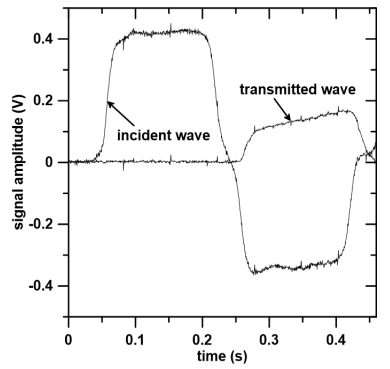
 DownLoad:
DownLoad: 